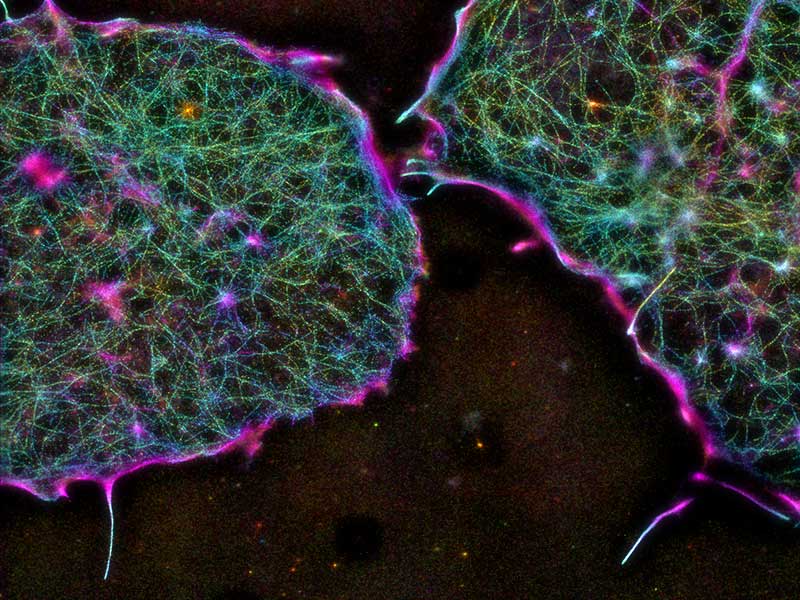Molecular machines sense and transduce mechanical force
Proteins that are activated or suppressed by mechanical force allow eukaryotic cells, such as those that make up the human body, to respond to changes in their microenvironment. This is crucial during development, when cell niches are still forming. Similarly, the changes in our bodies that occur as we age can lead to an altered physical environment for our cells—for example, bones may become softer, and scar tissue can build up.

Superresolution imaging reveals that E-cadherin assembles as distinct, punctate clusters. Detailed imaging at the nanoscale level demonstrates that these clusters do not merge (dotted red box). Read the full article: Defining Adhesion Clusters
By manipulating specific proteins and subjecting cells to a level of physical force consistent with that which occurs naturally in the human body, we are gaining a better understanding of how various molecular machines detect and transduce physical forces. Of particular interest are contractile cytoskeletal units, cadherin-based adhesion complexes, which connect cells with one another, and integrin-based adhesion complexes, which enable cellular interaction with the extracellular matrix.
Several proteins found in these machines can be stretched, thereby exposing domains that will bind additional proteins. This mechanism is replicated in MBI laboratories at the level of single proteins. Understanding the forces required to stretch a protein, to trigger contraction of an actomyosin based complex, or to induce a biochemical change in a protein provides crucial information on how cells integrate physical force into biochemical pathways.
Physical forces are integrated into biochemical pathways to impact genome regulation
Signals established at the cell periphery, or within the cytoskeleton, may converge on the cell nucleus where they will impact genome regulation and protein expression.
At the MBI, we investigate how mechanical cues regulate key signaling pathways, such as the Hippo pathway, and subsequently, the activity of various transcription machinery. In these cases physical cues, which may generated through the contraction or stretching of a protein complex, can lead to the recruitment or activation of other enzymes and transcription factors. Physical force is subsequently converted to a biochemical signal.
Alternatively, mechanical signals may be transferred through the cell as a physical force. For example, when the cytoskeleton contracts, or when an alteration in cell morphology generates tension within the nuclear membrane, the forces involved are transferred throughout the cell. The effect of transferring force through structural elements of the cell is investigated at the MBI. For example, we grow cells on substrates of a defined shape and monitor how nuclear morphology is affected, and in turn, how this phenomenon alters DNA packaging and the spatial arrangement of genes. Through this work, the importance of mechanics in the regulation of the genome is becoming evident.

As talins of decreasing lengths were introduced, focal adhesions became shorter, showing that talin was determining the height of the focal adhesion. Read the full article: Dissecting Focal Adhesions
The biophysics of bacterial pathogenesis
Like their larger multicellular hosts, bacteria and other prokaryotic cells are subjected to, and generate, mechanical forces. When invading a host cell, forces must be overcome, and in some cases, the dynamic structures of the host cell may be exploited by bacteria to facilitate their invasion.
For example, bacteria can modulate the cell membrane and manipulate the cytoskeleton for entry into the host, or for the secretion of virulence factors. In doing so the bacteria are able to establish an infection. However, the precise molecular mechanisms underlying bacterial uptake, and the mechanisms by which bacteria can evade the body’s defenses remain unclear. At MBI, we are investigating the biophysical aspects of bacterial pathogenesis, and in particular, are interested in the mechanisms by which bacteria like Salmonella utilize the endocytic membrane trafficking pathway to survive within the host. In this case, Salmonella will survive within an endosomal compartment called the salmonella containing vacuole (SCV). Salmonella also thrives within its host in a non-infectious phase for an extended period of time. Here, the bacteria will exist as a biofilm. How salmonella lives within SCVs, the various cytoskeletal modifications that take place during invasion and the regulatory mechanisms that are modulated to enable Salmonella to exist as a biofilm, are all researched at MBI.
Additional work in this area is looking at the formation and nature of cytoskeletal pedestals, which, in the case Enteropathogenic E.coli (EPEC) infection, are found within host cells at the site of bacterial attachment.
Featured Research in Molecular Mechanobiology
Building a mechanobiological signaling scaffold for the heart
A collaboration between MBI scientists and clinical researchers revealed how a scaffolding protein integrates biochemical and mechanical signals to control cardiac muscle cell differentiation. Learn more
MBI PIs win MOE AcRF Tier 3 grant to study endomembrane aging
A research team led by Mechanobiology Institute (MBI) Principal Investigators Assoc. Prof. Tony Kanchanawong and Prof. Rong Li was recently awarded a Ministry of Education Academic Research Fund (MOE AcRF) Tier 3 grant.
A molecular brake
Recent study led by MBI Research Fellows Pan Meng and Ti Weng Chew and Principal Investigator Associate Professor Low Boon Chuan has revealed a role for BNIP-2 protein in scaffolding GEF-H1 and RhoA, following microtubule disassembly, and has described how this scaffolding is important for RhoA-dependent regulation of cell migration. Learn more
When spacing matters
Dr Rishita Changede of the Sheetz Lab is exploring how the spacing between matrix protein fibers affect clustering of the cell surface receptors integrins and how this influences the formation of integrin-mediated cell-matrix adhesions and subsequent cell spreading. Learn more
Molecular controllers of stem cell mechanics
Recent study led by MBI graduate student Shumin Xia and Principal Investigator Associate Professor Pakorn Tony Kanchanawong use super resolution imaging techniques to study the nanoscale organization of the cortical actin cytoskeleton in mouse embryonic stem cells and understand the role of molecules such as Arp2/3, formins, and capping protein in coordinating cortical architecture in mESCs.
Pulling biomolecular complexes
MBI scientists demonstrate how the phenomenon of force-induced stabilization of biomolecular complexes can be explained on a one-dimensional energy landscape by incorporating defined transition coordinates.
Molecular Mechanobiology Researchers
Pakorn Tony KANCHANAWONG
Super-resolution microscopy, integrin-mediated cell adhesions, nanoscale architecture of cellular structures
Michael SHEETZ
Cell migration, cell-cell and cell-substrate interaction
GV SHIVASHANKAR
Nuclear mechanics and genome regulation
YAN Jie
DNA mechanics, single molecular manipulation and imaging
MBI Publications in Molecular Mechanobiology
Latest Publications
- Tan X, Ravasio A, Ong HT, Wu J, and Hew CL. White spot syndrome viral protein VP9 alters the cellular higher-order chromatin structure. FASEB Bioadv 2020; 2(4):264-279. [PMID: 32259052]
- Liu Y, Tran BN, Wang F, Ounjai P, Wu J, and Hew CL. Visualization of Assembly Intermediates and Budding Vacuoles of Singapore Grouper Iridovirus in Grouper Embryonic Cells. Sci Rep 2016; 6:18696. [PMID: 26727547]
- Gu Y, Tang X, Zhang X, Song C, Zheng M, Wang K, Zhang J, Ng M, Hew C, Li S, Xia N, and Sivaraman J. Structural basis for the neutralization of hepatitis E virus by a cross-genotype antibody. Cell Res. 2015; 25(5):604-20. [PMID: 25793314]
- Wang F, Zhu Y, and Hew CL. Quantitative study of proteomic alterations in a Zebrafish (danio rerio) cell line infected with the Singapore Grouper Iridovirus (SGIV). Virus Res. 2015; 199:62-7. [PMID: 25662022]
Bridging the (BP)GAP in metastasis
A collaborative study between researchers at MBI and scientists locally and overseas discovered how a scaffolding protein synchronizes, in space and time, two important regulatory proteins driving cell migration Learn more
Building a mechanobiological signaling scaffold for the heart
A collaboration between MBI scientists and clinical researchers revealed how a scaffolding protein integrates biochemical and mechanical signals to control cardiac muscle cell differentiation. Learn more
MBI PIs win MOE AcRF Tier 3 grant to study endomembrane aging
A research team led by Mechanobiology Institute (MBI) Principal Investigators Assoc. Prof. Tony Kanchanawong and Prof. Rong Li was recently awarded a Ministry of Education Academic Research Fund (MOE AcRF) Tier 3 grant.
A molecular brake
Recent study led by MBI Research Fellows Pan Meng and Ti Weng Chew and Principal Investigator Associate Professor Low Boon Chuan has revealed a role for BNIP-2 protein in scaffolding GEF-H1 and RhoA, following microtubule disassembly, and has described how this scaffolding is important for RhoA-dependent regulation of cell migration. Learn more
When spacing matters
Dr Rishita Changede of the Sheetz Lab is exploring how the spacing between matrix protein fibers affect clustering of the cell surface receptors integrins and how this influences the formation of integrin-mediated cell-matrix adhesions and subsequent cell spreading. Learn more












